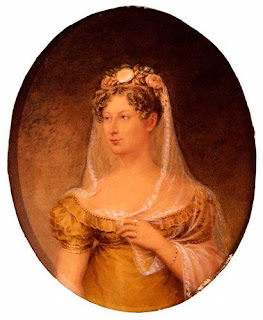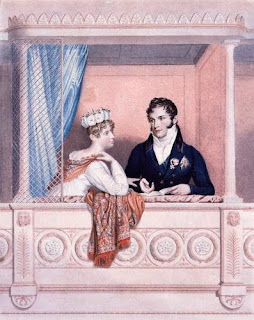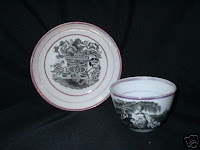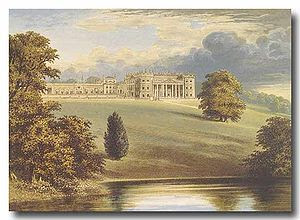
This is the birthday of Caroline of Brunswick (17 May 1768 – 7 August 1821), Princess of Wales, Queen Consort of King George IV, one of the saddest characters in the last 200 years of British royal history. Many have pointed out the parallels between Caroline’s life and the more recent sad Princess of Wales, Diana.

Both married men who loved another woman (or women, in the case of George), both were loved by the public, both engaged in questionable romantic relationships outside of their royal marriages, and both died well before their husbands.
George, Prince of Wales, later Prince Regent and then King George IV, already had a wife when he found himself out of funds again, and had to appeal to his father, George III, and governmental leaders in Parliament for an increase in his allowance.
Some probably knew of the marriage ceremony in which Prince George had illegally wed Mrs. Maria Fitzherbert. But since the wedding of a royal heir required the permission of the king, the marriage did not exist officially. So in return for an increase in his allowance, Prince George agreed to wed Caroline of Brunswick-Wolfenbüttel, his cousin from a German principality. The wedding took place April 8,1795.
The marriage was a disaster from the beginning. Prince George did not care for the appearance or the hygiene of his bride. She thought he was much fatter than his pictures and a drunkard. Worse, he flaunted one of his mistresses, Lady Jersey, by making her Caroline’s lady-of-the-bedchamber, which Caroline did not appreciate. (See Kristine’s post on the Two Lady Jerseys posted April 2, 2010). George and Caroline separated almost immediately and lived in distant households for the rest of their lives.
However, nine months later, Princess Charlotte was born on January 7, 1796, and became the heir to the throne after her father and grandfather. To the right, Caroline and Princess Charlotte of Wales by Sir Thomas Lawrence, 1802.
We will tell Charlotte’s sad story another day, but it suffices to say that both Caroline and Charlotte led unhappy lives because Prince George tried to ignore their very existence. Eventually, Charlotte married and later died in childbirth in 1817.
By then, Princess Caroline, her mother, was living in Italy at the Villa d’Este on Lake Como. (Victoria will post about this the Villa, now a hotel, soon.)
Caroline was living the high life, it was said, and had a very close friendship with a certain Signor Bartolmeo Pergami, which was widely caricatured.
After George III died in 1820, George IV had Caroline tried for adultery in the House of Lords. Though many believed she was guilty, it was not proved, to the King’s great irritation. He refused to allow Caroline to enter Westminster Abbey for his coronation in July of 1821. She died just a few weeks later on August 7, 1821. To the left, a detail of the Trial of Queen Caroline by Sir George Hayter.
There were inquiries into the cause of Caroline’s death, but again, nothing could be proven. She was buried in Brunswick.
 To the left, a portrait of Queen Caroline by James Lonsdale. Caroline always had a popularity with many of the people who despised her husband for his profligate ways, overspending and general excesses in everything. Jane Austen famously wrote, “I will always support her as long as I can, because she is a woman, and because I hate her husband…I am resolved at least always to think that she would have been respectable, if the Prince had behaved only tolerably by her at first.” (From letter of 16 February 1813 to Martha Lloyd)
To the left, a portrait of Queen Caroline by James Lonsdale. Caroline always had a popularity with many of the people who despised her husband for his profligate ways, overspending and general excesses in everything. Jane Austen famously wrote, “I will always support her as long as I can, because she is a woman, and because I hate her husband…I am resolved at least always to think that she would have been respectable, if the Prince had behaved only tolerably by her at first.” (From letter of 16 February 1813 to Martha Lloyd) Flora Fraser published her excellent book The Unruly Queen: the Life of Queen Caroline in 1996. It tells most of the story in detail with many more pictures. But, of course, the questions remain, nearly 200 years later. Was her behavior as bad as George IV’s was? Probably not. He was the penultimate spoiled child, self indulgent to the extreme. But no one probably will ever know the full story of Caroline, the forgotten queen.
Flora Fraser published her excellent book The Unruly Queen: the Life of Queen Caroline in 1996. It tells most of the story in detail with many more pictures. But, of course, the questions remain, nearly 200 years later. Was her behavior as bad as George IV’s was? Probably not. He was the penultimate spoiled child, self indulgent to the extreme. But no one probably will ever know the full story of Caroline, the forgotten queen. 

















